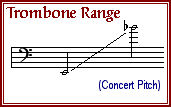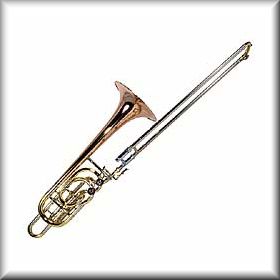
The trombone is the simplest of the modern brass instruments, consisting of a mostly cylindrical brass tube with only two major bends. The bell flare generally begins near the second bend (which is also the most common location for the tuning slide), covering one-fourth to one-third of the length of the tube.
The tenor trombone is pitched in B-flat, with a nominal fundamental tube length of nine feet. The range is identical to that of the baritone horn. Because the bore of the instrument is straight and cylindrical for much of the length, the trombone has the brightest sound of any of the usual brass band instruments. The slide makes the instrument capable of unique effects, the most well-known being the glissando.
The pitch of the instrument is altered by changing the length of the main tube using a large, freely-moving slide. There are seven slide positions, each corresponding to one of the seven valve combinations on a three-valved instrument. In the first position, the slide is fully retracted.. Each succeeding position lowers the fundamental pitch by one half-step.

Many trombones, especially all modern bass trombones, are fitted with valves that are operated by the player’s left hand (assuming a righthanded player). On tenor trombones, there is generally one valve of the rotary pattern, which engages a loop of tubing lowering the pitch 2.5 steps, equivalent to the sixth position or the first + third valve combination. This is sometimes termed an F attachment, since it has the effect of changing the fundamental note from B𝄬 to F. A trombone with feature should not be confused with the valve trombone, a generally inferior instrument shaped like a trombone but with a trumpet-like piston valve block and no main slide.
Role in the Brass Band
In four-part arrangements, trombones are assigned the tenor or bass part in the case of the bass trombone. In larger arrangements, trombones are often used to color the sound, The trombone is often used as a solo instrument. As with the cornet, the trombone sound is frequently altered by using various types of mutes, the most common being the straight mute and the cup mute.
Because of its bright timbre, the trombones often combine with the cornets for a brilliant sound, in or in contrast to the mellow instruments of the band. When combined with tenor horns and baritones, the trombone sound can easily dominate.
Bass Trombone

The bass trombone is a larger version of the common tenor trombone. Modern bass trombones have one or more valves, operated with the players left hand. These are sometimes referred to as “triggers” becaue of the operating mechanism. Older bass trombones without valves had extra-long main slides, with a small swivel handle attached to allow the player to reach the lower positions. Bass trombones are sometimes referred to as E𝄬, F, or G trombones. In the brass band score, the bass trombone is unique as the only instrument with parts written in the bass clef at concert pitch. All other brass instruments in the band use parts written in the treble clef, even the tubas.
There is generally only one bass trombone in a band, and players are considered specialists. It is rarely used as a solo instrument. The most powerful instrument in a brass band, the chacteristic blare of the bass trombone fortissimo is a familiar and essential part of the brass band sound.
